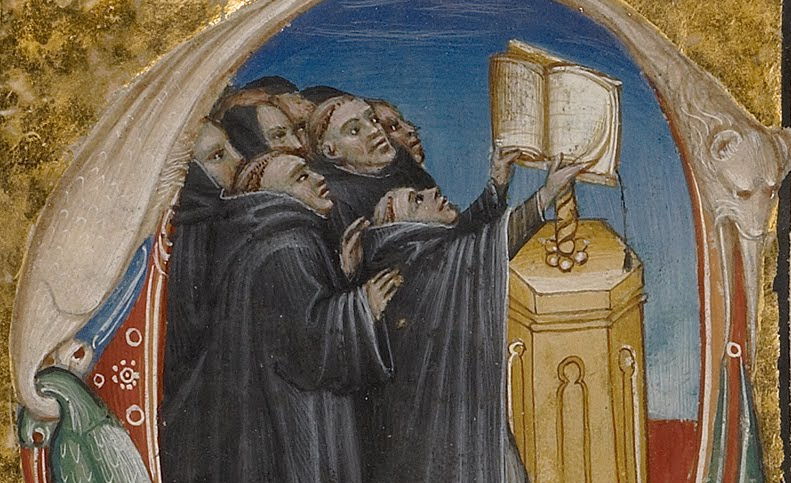
Opus Dei
The opus Dei was the raison d'étre
of the professed Benedictine. The physical and mental strictures of the RB, and
the intellectual and spiritual training devised by its disciples, were
conceived purely to support the sequence of offices, masses and other observances
that punctuated the conventual day:
giving up their own will' to follow 'the master's command and the
disciple's finished work' (RB, v). The sequence of day and night offices was
not new to Benedict: it had been an evolving element of monastic practice since
at least the second century and appeared in a form comparable to the RB in
fourth-century monasteries witnessed by Cassian and in the pioneering colonies
of southern France, such as those supervised by Caesarius of Arles. It is often
claimed that Benedict's achievement was to codify diffuse forms of observance,
but the foundation of a common horarium was already apparent at the
beginning of the sixth century, and to his contemporaries the RB appeared to be
only one of a number of regional and stylistic variants. Benedict's primary
contribution was to synthesize the practice of the churches of Rome with
emerging monastic custom. Over time his recension also proved to possess a
clarity and simplicity — a certain sparseness of description — that rendered it
more adaptable to different cultural, ecclesiastical and institutional
circumstances.
The development of Benedictine life over the Middle Ages was driven in large measure by the demands of the opus Dei. The primary impulse in the first phases of reform in the ninth (Benedict of Aniane) and tenth (Berno of Cluny) centuries was for a return to ad literam observance of the Office. The pioneers at Cluny privileged the opus at the expense of other occupations: Anselm of Canterbury later confessed to a fear of their regime: 'If at Cluny all the time I have spent in study will be lost.’ Later codes, Æthelwold's Regularis Concordia and Lanfranc's Decreta, aimed to embellish the opus so as to enhance its spiritual power but not to alter its essential structure. In the Gregorian period, as the clerical orders multiplied, the opus Dei was upheld by the governors of the order, and by its secular observers, as the monks' distinctive contribution to Mother Church and their most valuable currency in the material world. After 1215 papal reformers sought to stem what they saw to be an incipient decline. Yet the chapters of the Benedictines were concerned to lighten the liturgical burden, not only the supernumerary commemorations required by benefactors, but also the incremental elaboration of the Office itself. The 1277 canons of the English chapters trimmed psalms and responses from the daytime offices and sought to standardize and simplify the seasonal variations; further revisions were promulgated in 1343 and again in 1444. 19 The pressure for pure observance of the Benedictine Office remained constant at least in England, where the intervention of the Lancastrian regime — at the Council of Westminster in 1421 — added weight to the views of episcopal visitors. These tensions should not be interpreted as a sign of the terminal decline of the opus Dei or the abandonment of the Office. The capitular canons had removed accretions and anomalous variations, but the rhythm of the liturgical round remained intact. There were perhaps greater interruptions to traditional observance in the reformed congregations of Bursfeld, Melk and Padua, where the observant hours were eclipsed by a program of claustral lectures. Certainly, in England the patterns of liturgy familiar to Black Monks of the early and high Middle Ages were still performed on the eve of the Dissolution. At Evesham Abbey the completion of the office was the final act of the brethren before passing out of the precinct forever.
No comments:
Post a Comment